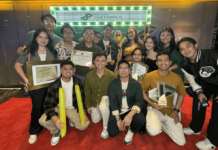IT WAS meant to be a simple bulletin board display, but it grew into a medicine museum, perhaps the first of its kind in the country.
The former Dr. Gabriel History of Medicine and Forensic Medicine Museum was unveiled as the UST Medicine Museum last June 17. Situated in the second floor of the Medicine Bldg., the museum exudes a clinic-like ambiance with the medical artifacts on display.
On exhibit are old stethoscopes, blood pressure meters, endoscopes, and other machines vital to the preservation of life. A yellowish skeleton stands guard over the myriad of medical relics.
Conceived in the mid-60’s by Dr. Antonio Gabriel, the museum does not stray from its intended function as a pictorial exhibit to chronicle the history of forensic medicine in the Faculty of Medicine and Surgery. Father Regent Jerry Manlangit, O.P., and Dean Dr. Rolando Lopez have develop the exhibit into the museum.
A miniature shrine tucked in one corner reminds of the Faculty’s role in Philippine medical history. Small “relics” are lined up in a glass shelf with printed pictures and documents to explain what they signify.
“If you look at the progress of medicine in the Philippines, it can actually be traced back to the history of the Faculty of Medicine and Surgery,” museum curator Dr. Norberto V. Martinez told the Varsitarian.
The small relics explain the condensed history of both UST and Philippine medicine, starting from the anting-anting or amulets of native doctors to the relatively modern medicine introduced by the Dominicans. But it took 250 years for the Dominican administrators of the University to lay the foundations for the Faculty, as presented in the exhibit.
There is a two-dimensional photograph collection that illustrates the history of medical arts in the country. There are a number of pictures from the old UST campus in Intramuros, and a copy of Dr. Jose Rizal’s school report card, where he got a sobresaliente or excellent mark in one of his medicine subjects.
Rare books on medicine, commemorative stamps featuring the Faculty of Medicine and Surgery and the Faculty of Pharmacy, and other memorabilia linked to the history of UST Medicine, are also on permanent display.
“This is a very comprehensive museum. Here you have some historical insight, as well as equipment that have been truly used during past eras,” Martinez said.
It was the UST Medical Alumni Foundation International that sponsored the collection.
“The alumni, or even families of some alumni, would turn over whatever memorabilia they have in store, thinking it would be of better use here,” Martinez said. “They are very valuable for us, since we are trying to trace back the history of medicine.”
Various organizations and departments hold exhibits in the museum, which is the main exhibit area of the Faculty. Students from several schools regularly visit the museum for their class field trips.
In the future, the museum administration hopes to publish a book detailing the joint history of Philippine and UST medicine, which would tackle the colorful beginnings and development of the Faculty of Medicine and Surgery.













